One of the biggest challenges that arise when working in a studio is that you’re essentially shooting in a plain rectangular box. When photographing portraits, the two obvious ways out of that is to create an interesting (or complementary) background, and then to create interesting (or flattering) lighting.
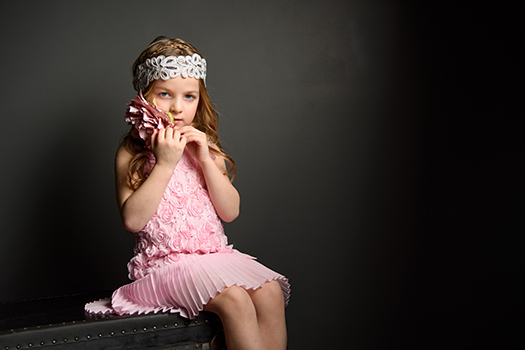
All photos © Neil van Niekerk
Flower Girl
There seems to be a natural progression with photographers exploring off-camera flash and studio photography. After the initial umbrella and softbox, the next purchase is usually a beauty dish, and then other esoterica such as a ring flash. I’d suggest that one of the first light modifiers anyone should get is a small- or medium-sized gridded stripbox. It’s narrower than the usual softboxes, and the grid really helps contain the light spread. You have the ability to get relatively soft light, but also control it much better than a regular softbox, and especially an umbrella.
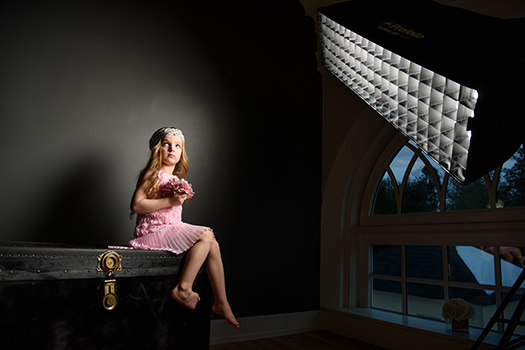
This portrait of Gracie Jane was shot with just one main light, a 1 x 4-foot gridded stripbox. I can rotate the stripbox to make it vertical, horizontal or any angle in between. I can also rotate the stripbox on the light stand so that the top of the stripbox is closer to the wall, letting light fall between my subject and the background (the grey wall) to create a gentle but dramatic fall-off in light. By swinging the stripbox around, I can use the one end to give more fill light on my subject. It is one of those things that you have to actually try for yourself and see how infinitely changeable the light from such a gridded stripbox can be.
Camera: Nikon D810
Lens: Nikon 24-70mm f/2.8E VR
Exposure: f/5.6 at 1/125 sec. and 200 ISO
Lighting: Profoto D1 flash head, Profoto 1 x 4 gridded stripbox
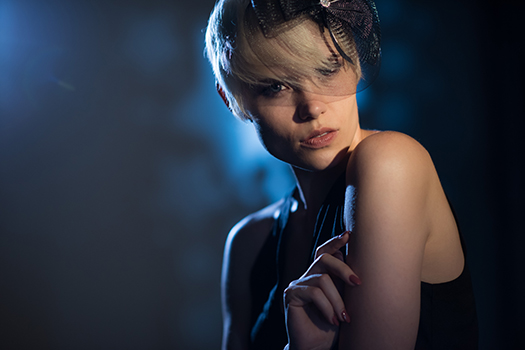
Starry Eyed
My model Jessica Joy Thompson’s reaction to the test shot for this dramatic, Hollywood glamour-inspired portrait was amusing—a surprised “where did that come from?” when she looked at the back of my camera. The pattern in the background was an unexpected dramatic effect. When I positioned her in the middle of the studio floor, only the two Litepanels Sola 4 LED Fresnel lights were shining, until I fired the shutter and a Light Blaster with a star-pattern gobo went off.
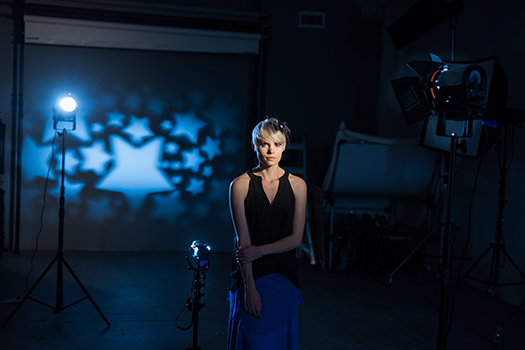
The lighting for this photo needed to be considered as two layers: the continuous light (via the LED Fresnel lights) and the flash via the Light Blaster on the background. I gelled the main LED Fresnel light with an incandescent balanced gel. With my camera set to an appropriate white balance, the daylight-balanced Fresnel hair light and the flash pattern on the wall turned blue.
Camera: Nikon D810
Lens: Nikon 85mm f/1.4G
Exposure: f/2 at 1/200 sec. and 800 ISO
Lighting: Litepanels Sola 4 LED Fresnel lights (x2), Light Blaster with a star gobo
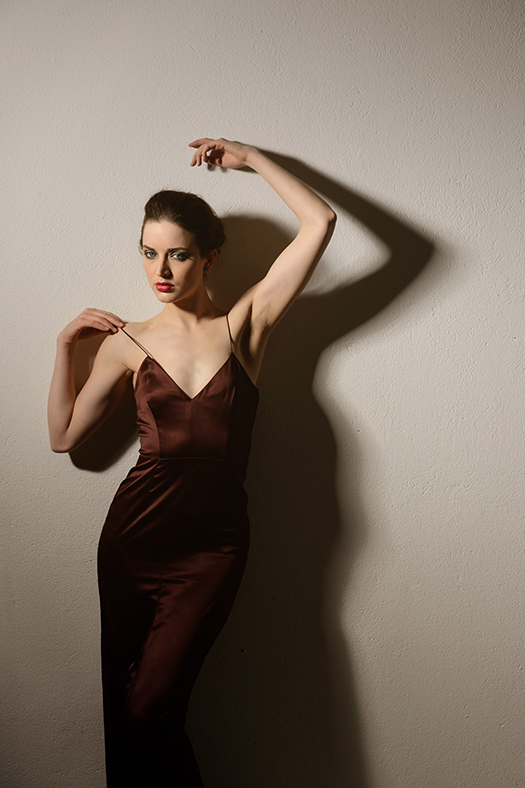
For Shadowing
In the other examples here, the interplay between light and shade was essential in creating dramatic light. We can take it a step further, and make the shadows part of the design of the photograph. A harder light source works better for this purpose.
When I first started exploring bounce flash (and then off-camera flash and then studio photography), my instincts veered toward softer light. A large light source gives you softer light, which is also more forgiving in terms of how you position your subject and yourself in relation to the light. It’s easy to work with because it creates softer light that easily wraps around your subject. As flattering as it is, it soon became obvious that I was missing out on that dramatic element that attracted me to certain images and what I saw in movies.
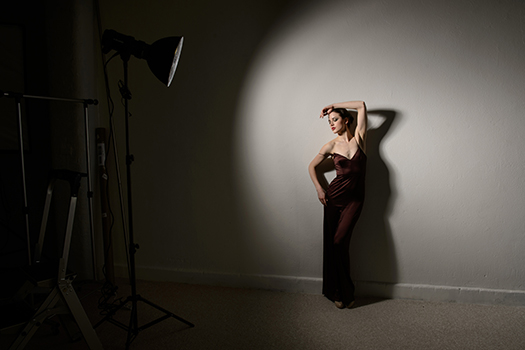
Selectively lighting part of your subject—or just using a smaller, harder light source as a single light—gives you more opportunity for different looks than just using one large light source. In photographing Anelisa for a promotional video clip for my studio, I used smaller light sources for several of the setups. Here, I used the Profoto 50-degree Magnum Reflector to concentrate the light while still giving a wide enough beam.
And afterward, I applied a warm tone in post-production to give it a sun-drenched effect.
Camera: Nikon D4
Lens: Nikon 24-120mm f/4 VR
Exposure: f/8 at 1/200 sec. and 100 ISO
Lighting: Profoto D1 Air 500W/s Monolight, 50-degree Magnum Reflector
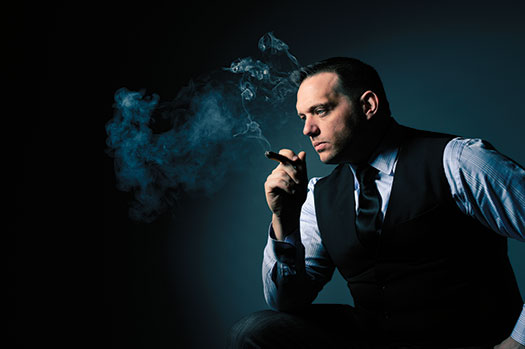
Smoke and Mood
I love the forgiving nature of large light modifiers. You don’t have such precision with a huge softbox as you do with a smaller, more contrast-y light modifier, but you also have less opportunity for dramatic light as you do with smaller light sources. In line with the idea that a smaller light = harder light = dramatic light, I wanted to create a series of portraits that had a darker, moodier feel.
Brian Calabrese, a photographer friend of mine, met up with me in my studio, and through various iterations of how to position him and place the light, we got some stunning portraits of him.
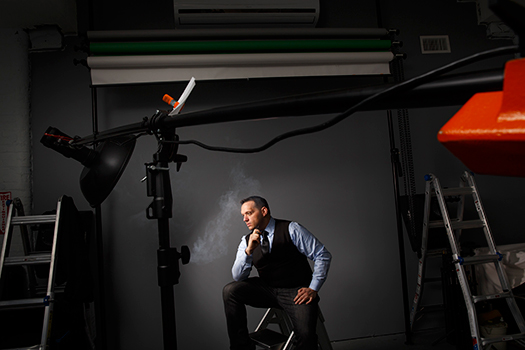
In trying to use the beauty dish as a dual light—illuminating Brian’s features and as spill light on the background—it took careful positioning. The beauty dish was on a movable boom, and I kept the weight end of the boom close to me so I could just reach out and adjust the light’s placement. I asked Brian to turn his gaze downward, which meant the light had to be lower. We took a number of test shots until we had it just right.
In the final image, I used 669 Shadows Cyan in Alien Skin Exposure 7 to give the image that blue-ish tone that looks like a cross-processed photo.
Camera: Nikon D810
Lens: Nikon 70-200mm f/2.8G VR
Exposure: f/8 at 1/160 sec. and 100 ISO
Lighting: Profoto D1 flash head, Profoto beauty dish (with honeycomb grid)
Neil van Niekerk is a world-renowned photographer based in New Jersey, specializing in weddings and portraits. He has presented workshops on lighting in the USA, the UK, Ireland and Amsterdam, and he’s written several books on flash photography and lighting. He also maintains a website for photographers, neilvn.com/tangents, which is loaded with tutorials and useful info for photographers.
To read this article in the digital edition, click here.




